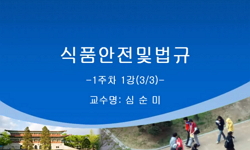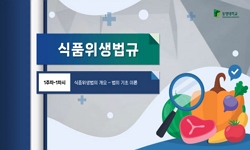본 연구에서는 김치 제조시 철저한 재료 세척의 필요성을 확인하고, 더불어 비가열 식품인 김치의 위생 안전성 실태를 파악하여 효율적 미생물 저감화 방안을 마련하고자 국내에서 유통되...
http://chineseinput.net/에서 pinyin(병음)방식으로 중국어를 변환할 수 있습니다.
변환된 중국어를 복사하여 사용하시면 됩니다.
- 中文 을 입력하시려면 zhongwen을 입력하시고 space를누르시면됩니다.
- 北京 을 입력하시려면 beijing을 입력하시고 space를 누르시면 됩니다.
https://www.riss.kr/link?id=A105311135
- 저자
- 발행기관
- 학술지명
- 권호사항
-
발행연도
2018
-
작성언어
English
- 주제어
-
등재정보
KCI등재
-
자료형태
학술저널
- 발행기관 URL
-
수록면
94-101(8쪽)
- 제공처
- 소장기관
-
0
상세조회 -
0
다운로드
부가정보
국문 초록 (Abstract)
본 연구에서는 김치 제조시 철저한 재료 세척의 필요성을 확인하고, 더불어 비가열 식품인 김치의 위생 안전성 실태를 파악하여 효율적 미생물 저감화 방안을 마련하고자 국내에서 유통되는 김치 원 부재료 200건의 세척 전과 후의 비교분석과 시판 김치 100건에 대하여 미생물 분석을 실시하였다. 김치 원 부재료 및 완제품에 대하여 일반세균수, 대장균 및 대장균군을 모니터링 하였으며, 병원성 미생물 9종(Bacillus cereus, Clostridium perfringens 정성 정량, Staphylococcus aureus, Enterohemorrhagic Escherichia coli, Campylobacter jejuni/coli, Yersinia enterocolitica, Salmonella spp., Vibrio parahaemolyticus, Listeria monocytogenes 정성)을 분석 하였다. 모니터링 결과, 김치 원 부재료 및 완제품에서 일반세균은 1.4~9.0 log CFU/g 수준으로 확인되었으며, 원 부재료 중 생강에서 8.8 log CFU/g, 완제품 중 총각김치에서 9.0 log CFU/g으로 일반세균이 가장 높게 나타났다. 대장균군은 0.5~7.3 log CFU/g으로 확인되었으며, 생강에서 7.3 log CFU/g으로 가장 높게 나타났고, 병원성 미생물 9종의 분석결과, Bacillus cereus를 제외한 나머지 8종의 식중독균은 모든 시료에서 검출되지 않았다. 김치 제조 시 사용되는 김치 원 부재료들의 세척공정 후 미생물 수는 일반세균수 0.2~3.2 log CFU/g, 대장균군 0.3~2.7 log CFU/g, Bacillus cereus 1.0~3.9 log CFU/g 감소하였다. 따라서, 김치 원 부재료의 세척 공정으로 미생물 오염도를 감소 시켰으며, 이 결과를 통하여 김치 완제품의 위생 및 저장성 증진에 기여 할 수 있을 것으로 확인되었다.
다국어 초록 (Multilingual Abstract)
Although Kimchi has health benefits, food poisoning associated with consumption of Kimchi has been frequently reported. Accordingly, microbiological properties of Kimchi (100 samples) and washing effects on microbial reduction against its ingredients ...
Although Kimchi has health benefits, food poisoning associated with consumption of Kimchi has been frequently reported. Accordingly, microbiological properties of Kimchi (100 samples) and washing effects on microbial reduction against its ingredients (200 samples) were examined. Total aerobic bacteria, coliforms, Escherichia coli, Bacillus cereus, and Clostridium perfringens were quantified. In addition, B. cereus, Salmonella spp., Enterohemorrhagic E. coli, C. perfringens, Campylobacter jejuni/coli, Staphylococcus aureus, Vibrio parahaemolyticus, Listeria monocytogenes, and Yersinia enterocolitica were analysed qualitatively. Total aerobic bacteria count was approximately 1.4-9.0 log CFU/g, which were highest in ginger (8.8 log CFU/g), and Chonggak Kimchi (9.0 log CFU/g). The range of coliform counts detected in all raw materials was 0.5-7.3 log CFU/g and ginger showed the greatest number 7.3 log CFU/g among others. Contamination was decreased to 0.2-3.2, 0.3-2.7, and 1.0-3.9 log CFU/g for total aerobic bacteria, coliforms, and B. cereus, respectively, after washing. Minimising microbial contamination in Kimchi ingredients is necessary to ensure the safety of Kimchi. These results indicate that washing is a useful method to reduce bacterial contamination in Kimchi.
동일학술지(권/호) 다른 논문
-
- The Korean Society of Food Hygiene and Safety
- Hahm, Tae-Shik
- 2018
- KCI등재
-
- The Korean Society of Food Hygiene and Safety
- Hong, Yewon
- 2018
- KCI등재
-
국내 유통 폴리락타이드(PLA) 식품용 기구 및 용기·포장의 중금속 이행량 모니터링
- 한국식품위생안전성학회
- 김현욱
- 2018
- KCI등재
-
LC-MS/MS 및 GC-MS/MS를 활용한 수산물 중 디아제팜의 정량분석법 개발
- 한국식품위생안전성학회
- 신다솜
- 2018
- KCI등재






 ScienceON
ScienceON







